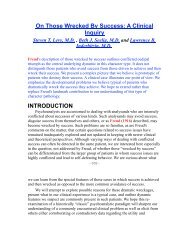A Sadomasochistic Transference - Beth J. Seelig, MD
A Sadomasochistic Transference - Beth J. Seelig, MD
A Sadomasochistic Transference - Beth J. Seelig, MD
Create successful ePaper yourself
Turn your PDF publications into a flip-book with our unique Google optimized e-Paper software.
in addition to their role in narcissistic regulation, erotization of suffering,<br />
stabilization of self-esteem. Surrender and masochism, domination and sadism,<br />
then, are "perverse" characterological adaptations that preserve some remnant of<br />
mutuality. (We use the term "perverse" here as analogous to the perverse sexual<br />
solution in which sexual pleasure is preserved, though at a high cost.)<br />
<strong>Sadomasochistic</strong> pathology allows the individual to maintain intimate though<br />
distorted human contact.<br />
Failure of Triangulation<br />
Distortions in the rapprochement subphase often have negative implications<br />
for the future development of triangulation. As is stressed by Atkins (1982) and by<br />
Galenson and Roiphe (1976), the mother can either facilitate or impede the<br />
establishment of<br />
- 986 -<br />
the early triangular configuration. Galenson and Roiphe (1976) have observed that<br />
if a little girl's rapprochement subphase has been particularly difficult, she will<br />
form only a shadowy oedipal romance with father, one that lacks the usual verve.<br />
For these girls, the highly ambivalent maternal bond appears to preclude the<br />
normal early turn to the father or any third person.<br />
In his articles on preoedipal triangulation, Abelin (1971), (1975) elaborates<br />
the important role of the father in the separation-individuation process and<br />
describes the individuating child as seeing itself in a "dual mirror" of father and<br />
mother. Mahler and Gosliner (1955) have described the father's role in the<br />
separation-individuation process as intervening between mother and child to aid in<br />
the child's differentiation from the symbiotic mother. Father provides a safe object<br />
for the individuating child, a refuge when the "mother of separation," imbued with<br />
the child's projected aggression, is too threatening. Herzog (1982) describes<br />
difficulties in modulation of aggression in children who have been deprived of<br />
their fathers by divorce. The special role that the father can serve in enhancing the<br />
daughter's self-esteem is described by Ross (1988), and his role in either fostering<br />
or inhibiting her later creativity has been reported by Tessman (1989,<br />
unpublished).<br />
How does the individuating child learn to "see" itself in the "dual mirrors"<br />
described by Abelin? How does the child integrate its reflection in the maternal<br />
and paternal mirrors, and what happens if one mirroring parent is missed and or<br />
distorts? Worse yet, what if one parent is virtually missing and the other<br />
consistently misreads the child's cues and provides a distorted reflection, as was<br />
the case in Miss T.'s childhood?<br />
In early childhood, the mother helps mold the infant's perceptions of self and<br />
other. One could say, she presents the child with her "point of view." The child




